[English] 日本語
 Yorodumi
Yorodumi- PDB-3faa: Crystal structure of TGFbRI complexed with a 2-aminoimidazole inh... -
+ Open data
Open data
- Basic information
Basic information
| Entry | Database: PDB / ID: 3faa | ||||||
|---|---|---|---|---|---|---|---|
| Title | Crystal structure of TGFbRI complexed with a 2-aminoimidazole inhibitor | ||||||
 Components Components | TGF-beta receptor type-1 | ||||||
 Keywords Keywords |  TRANSFERASE / TRANSFERASE /  Kinase / Kinase /  TGFbeta / TGFbeta /  structure-based drug design / protein-inhibitor complex / ATP-binding / structure-based drug design / protein-inhibitor complex / ATP-binding /  Craniosynostosis / Disease mutation / Craniosynostosis / Disease mutation /  Glycoprotein / Glycoprotein /  Magnesium / Magnesium /  Manganese / Manganese /  Membrane / Metal-binding / Nucleotide-binding / Membrane / Metal-binding / Nucleotide-binding /  Phosphoprotein / Polymorphism / Receptor / Phosphoprotein / Polymorphism / Receptor /  Serine/threonine-protein kinase / Serine/threonine-protein kinase /  Transmembrane Transmembrane | ||||||
| Function / homology |  Function and homology information Function and homology informationextracellular structure organization / epicardium morphogenesis / parathyroid gland development / transforming growth factor beta ligand-receptor complex / regulation of cardiac muscle cell proliferation / myofibroblast differentiation / positive regulation of tight junction disassembly / positive regulation of epithelial to mesenchymal transition involved in endocardial cushion formation / TGFBR2 Kinase Domain Mutants in Cancer /  transforming growth factor beta receptor activity ...extracellular structure organization / epicardium morphogenesis / parathyroid gland development / transforming growth factor beta ligand-receptor complex / regulation of cardiac muscle cell proliferation / myofibroblast differentiation / positive regulation of tight junction disassembly / positive regulation of epithelial to mesenchymal transition involved in endocardial cushion formation / TGFBR2 Kinase Domain Mutants in Cancer / transforming growth factor beta receptor activity ...extracellular structure organization / epicardium morphogenesis / parathyroid gland development / transforming growth factor beta ligand-receptor complex / regulation of cardiac muscle cell proliferation / myofibroblast differentiation / positive regulation of tight junction disassembly / positive regulation of epithelial to mesenchymal transition involved in endocardial cushion formation / TGFBR2 Kinase Domain Mutants in Cancer /  transforming growth factor beta receptor activity / positive regulation of mesenchymal stem cell proliferation / ventricular compact myocardium morphogenesis / SMAD2/3 Phosphorylation Motif Mutants in Cancer / TGFBR1 KD Mutants in Cancer / positive regulation of vasculature development / transforming growth factor beta receptor activity / positive regulation of mesenchymal stem cell proliferation / ventricular compact myocardium morphogenesis / SMAD2/3 Phosphorylation Motif Mutants in Cancer / TGFBR1 KD Mutants in Cancer / positive regulation of vasculature development /  regulation of epithelial to mesenchymal transition / activin receptor activity, type I / cardiac epithelial to mesenchymal transition / transforming growth factor beta receptor activity, type I / regulation of epithelial to mesenchymal transition / activin receptor activity, type I / cardiac epithelial to mesenchymal transition / transforming growth factor beta receptor activity, type I /  activin receptor complex / mesenchymal cell differentiation / neuron fate commitment / germ cell migration / positive regulation of extracellular matrix assembly / type II transforming growth factor beta receptor binding / TGFBR1 LBD Mutants in Cancer / angiogenesis involved in coronary vascular morphogenesis / activin receptor complex / mesenchymal cell differentiation / neuron fate commitment / germ cell migration / positive regulation of extracellular matrix assembly / type II transforming growth factor beta receptor binding / TGFBR1 LBD Mutants in Cancer / angiogenesis involved in coronary vascular morphogenesis /  receptor protein serine/threonine kinase / receptor protein serine/threonine kinase /  transmembrane receptor protein serine/threonine kinase activity / pharyngeal system development / transmembrane receptor protein serine/threonine kinase activity / pharyngeal system development /  activin binding / coronary artery morphogenesis / activin receptor signaling pathway / activin binding / coronary artery morphogenesis / activin receptor signaling pathway /  filopodium assembly / ventricular trabecula myocardium morphogenesis / filopodium assembly / ventricular trabecula myocardium morphogenesis /  transforming growth factor beta binding / embryonic cranial skeleton morphogenesis / response to cholesterol / transforming growth factor beta binding / embryonic cranial skeleton morphogenesis / response to cholesterol /  I-SMAD binding / negative regulation of chondrocyte differentiation / collagen fibril organization / endothelial cell proliferation / I-SMAD binding / negative regulation of chondrocyte differentiation / collagen fibril organization / endothelial cell proliferation /  endothelial cell activation / endothelial cell activation /  skeletal system morphogenesis / lens development in camera-type eye / positive regulation of filopodium assembly / anterior/posterior pattern specification / artery morphogenesis / ventricular septum morphogenesis / roof of mouth development / TGF-beta receptor signaling activates SMADs / SMAD binding / negative regulation of endothelial cell proliferation / positive regulation of SMAD protein signal transduction / blastocyst development / regulation of protein ubiquitination / endothelial cell migration / bicellular tight junction / skeletal system morphogenesis / lens development in camera-type eye / positive regulation of filopodium assembly / anterior/posterior pattern specification / artery morphogenesis / ventricular septum morphogenesis / roof of mouth development / TGF-beta receptor signaling activates SMADs / SMAD binding / negative regulation of endothelial cell proliferation / positive regulation of SMAD protein signal transduction / blastocyst development / regulation of protein ubiquitination / endothelial cell migration / bicellular tight junction /  epithelial to mesenchymal transition / positive regulation of epithelial to mesenchymal transition / positive regulation of apoptotic signaling pathway / positive regulation of stress fiber assembly / cellular response to transforming growth factor beta stimulus / positive regulation of endothelial cell proliferation / Downregulation of TGF-beta receptor signaling / post-embryonic development / transforming growth factor beta receptor signaling pathway / negative regulation of cell migration / thymus development / TGF-beta receptor signaling in EMT (epithelial to mesenchymal transition) / epithelial to mesenchymal transition / positive regulation of epithelial to mesenchymal transition / positive regulation of apoptotic signaling pathway / positive regulation of stress fiber assembly / cellular response to transforming growth factor beta stimulus / positive regulation of endothelial cell proliferation / Downregulation of TGF-beta receptor signaling / post-embryonic development / transforming growth factor beta receptor signaling pathway / negative regulation of cell migration / thymus development / TGF-beta receptor signaling in EMT (epithelial to mesenchymal transition) /  kidney development / kidney development /  skeletal system development / skeletal system development /  cell motility / negative regulation of extrinsic apoptotic signaling pathway / cell motility / negative regulation of extrinsic apoptotic signaling pathway /  wound healing / cellular response to growth factor stimulus / male gonad development / UCH proteinases / wound healing / cellular response to growth factor stimulus / male gonad development / UCH proteinases /  nervous system development / nervous system development /  heart development / positive regulation of cell growth / heart development / positive regulation of cell growth /  regulation of gene expression / peptidyl-serine phosphorylation / in utero embryonic development / positive regulation of phosphatidylinositol 3-kinase/protein kinase B signal transduction / regulation of gene expression / peptidyl-serine phosphorylation / in utero embryonic development / positive regulation of phosphatidylinositol 3-kinase/protein kinase B signal transduction /  receptor complex / receptor complex /  regulation of cell cycle / Ub-specific processing proteases / regulation of cell cycle / Ub-specific processing proteases /  endosome / endosome /  protein kinase activity / intracellular signal transduction / positive regulation of cell migration / protein kinase activity / intracellular signal transduction / positive regulation of cell migration /  membrane raft / protein serine/threonine kinase activity / apoptotic process / membrane raft / protein serine/threonine kinase activity / apoptotic process /  ubiquitin protein ligase binding / positive regulation of cell population proliferation / positive regulation of gene expression / regulation of DNA-templated transcription / positive regulation of DNA-templated transcription ubiquitin protein ligase binding / positive regulation of cell population proliferation / positive regulation of gene expression / regulation of DNA-templated transcription / positive regulation of DNA-templated transcriptionSimilarity search - Function | ||||||
| Biological species |   Homo sapiens (human) Homo sapiens (human) | ||||||
| Method |  X-RAY DIFFRACTION / X-RAY DIFFRACTION /  SYNCHROTRON / SYNCHROTRON /  FOURIER SYNTHESIS / Resolution: 3.35 Å FOURIER SYNTHESIS / Resolution: 3.35 Å | ||||||
 Authors Authors | Boriack-Sjodin, P.A. / Fitch, C. | ||||||
 Citation Citation |  Journal: Bioorg.Med.Chem.Lett. / Year: 2009 Journal: Bioorg.Med.Chem.Lett. / Year: 2009Title: 2-Aminoimidazoles inhibitors of TGF-beta receptor 1. Authors: Bonafoux, D. / Chuaqui, C. / Boriack-Sjodin, P.A. / Fitch, C. / Hankins, G. / Josiah, S. / Black, C. / Hetu, G. / Ling, L. / Lee, W.C. | ||||||
| History |
|
- Structure visualization
Structure visualization
| Structure viewer | Molecule:  Molmil Molmil Jmol/JSmol Jmol/JSmol |
|---|
- Downloads & links
Downloads & links
- Download
Download
| PDBx/mmCIF format |  3faa.cif.gz 3faa.cif.gz | 329.8 KB | Display |  PDBx/mmCIF format PDBx/mmCIF format |
|---|---|---|---|---|
| PDB format |  pdb3faa.ent.gz pdb3faa.ent.gz | 271.3 KB | Display |  PDB format PDB format |
| PDBx/mmJSON format |  3faa.json.gz 3faa.json.gz | Tree view |  PDBx/mmJSON format PDBx/mmJSON format | |
| Others |  Other downloads Other downloads |
-Validation report
| Arichive directory |  https://data.pdbj.org/pub/pdb/validation_reports/fa/3faa https://data.pdbj.org/pub/pdb/validation_reports/fa/3faa ftp://data.pdbj.org/pub/pdb/validation_reports/fa/3faa ftp://data.pdbj.org/pub/pdb/validation_reports/fa/3faa | HTTPS FTP |
|---|
-Related structure data
| Similar structure data |
|---|
- Links
Links
- Assembly
Assembly
| Deposited unit | 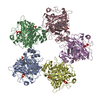
| ||||||||
|---|---|---|---|---|---|---|---|---|---|
| 1 | 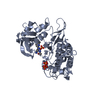
| ||||||||
| 2 | 
| ||||||||
| 3 | 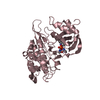
| ||||||||
| 4 | 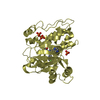
| ||||||||
| 5 | 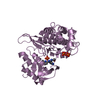
| ||||||||
| Unit cell |
|
- Components
Components
| #1: Protein | Mass: 38920.641 Da / Num. of mol.: 5 / Fragment: GS and Kinase domains: UNP residues 162-503 Source method: isolated from a genetically manipulated source Source: (gene. exp.)   Homo sapiens (human) / Cell line: SF9 / Gene: TGFBR1 / Production host: Homo sapiens (human) / Cell line: SF9 / Gene: TGFBR1 / Production host:   Spodoptera frugiperda (fall armyworm) Spodoptera frugiperda (fall armyworm)References: UniProt: P36897,  receptor protein serine/threonine kinase receptor protein serine/threonine kinase#2: Chemical | ChemComp-55F / #3: Chemical | ChemComp-PO4 /  Phosphate Phosphate |
|---|
-Experimental details
-Experiment
| Experiment | Method:  X-RAY DIFFRACTION / Number of used crystals: 1 X-RAY DIFFRACTION / Number of used crystals: 1 |
|---|
- Sample preparation
Sample preparation
| Crystal | Density Matthews: 3.87 Å3/Da / Density % sol: 68.26 % |
|---|---|
Crystal grow | Temperature: 293 K / Method: vapor diffusion, hanging drop / pH: 7.4 Details: Na/K phosphate, pH 7.4, VAPOR DIFFUSION, HANGING DROP, temperature 293K |
-Data collection
| Diffraction | Mean temperature: 100 K |
|---|---|
| Diffraction source | Source:  SYNCHROTRON / Site: SYNCHROTRON / Site:  NSLS NSLS  / Beamline: X25 / Wavelength: 1.1 Å / Beamline: X25 / Wavelength: 1.1 Å |
| Detector | Type: ADSC QUANTUM 315 / Detector: CCD / Date: Sep 12, 2005 |
| Radiation | Monochromator: Si(111) / Protocol: SINGLE WAVELENGTH / Monochromatic (M) / Laue (L): M / Scattering type: x-ray |
| Radiation wavelength | Wavelength : 1.1 Å / Relative weight: 1 : 1.1 Å / Relative weight: 1 |
| Reflection | Resolution: 3.2→50 Å / Num. all: 51040 / Num. obs: 50127 / % possible obs: 99.8 % / Observed criterion σ(I): 2 / Redundancy: 5.8 % / Rmerge(I) obs: 0.127 / Χ2: 1.056 / Net I/σ(I): 13.38 |
| Reflection shell | Resolution: 3.2→3.31 Å / Redundancy: 5.4 % / Rmerge(I) obs: 0.755 / Num. unique all: 5043 / Χ2: 0.657 / % possible all: 99.7 |
- Processing
Processing
| Software |
| ||||||||||||||||||||||||||||
|---|---|---|---|---|---|---|---|---|---|---|---|---|---|---|---|---|---|---|---|---|---|---|---|---|---|---|---|---|---|
| Refinement | Method to determine structure : :  FOURIER SYNTHESIS / Resolution: 3.35→35 Å / Occupancy max: 1 / Occupancy min: 0.5 / Cross valid method: THROUGHOUT / Stereochemistry target values: Engh & Huber FOURIER SYNTHESIS / Resolution: 3.35→35 Å / Occupancy max: 1 / Occupancy min: 0.5 / Cross valid method: THROUGHOUT / Stereochemistry target values: Engh & Huber
| ||||||||||||||||||||||||||||
| Displacement parameters | Biso max: 144.59 Å2 / Biso mean: 71.11 Å2 / Biso min: 7.15 Å2
| ||||||||||||||||||||||||||||
| Refinement step | Cycle: LAST / Resolution: 3.35→35 Å
| ||||||||||||||||||||||||||||
| Refine LS restraints |
| ||||||||||||||||||||||||||||
| Xplor file |
|
 Movie
Movie Controller
Controller


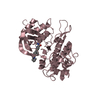

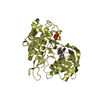
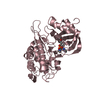
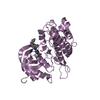

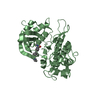
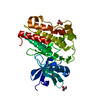

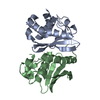
 PDBj
PDBj







